With the development of artificial intelligence, image recognition technology has become an indispensable part of our lives. Java, as a popular programming language, is no exception. In this article, we will introduce the development of image recognition applications in the Java language, including the basic knowledge of image recognition technology and related APIs and libraries in the Java language. The purpose of this article is to provide an overview and resources for developers who want to develop Java image recognition applications, so there is no need to have an in-depth understanding of image recognition algorithms and principles.
1. Basic knowledge of image recognition technology
Image recognition is an application based on machine learning and pattern recognition technology, which can identify specific targets or scenes in digital images. Generally speaking, image recognition technology is divided into the following steps:
- Image acquisition
In the image acquisition stage, we will use a camera or other image acquisition device to capture the target Shoot or record the scene. What needs to be noted here is that in image recognition applications, we need to capture different features of the target scene as much as possible, so as to improve the accuracy of image recognition.
- Image preprocessing
In the image preprocessing stage, we need to process the collected images to improve the quality of the images, and convert the original images into what the computer can The number format to handle. Generally, technologies such as pixel mapping, filtering, and noise reduction are used.
- Feature extraction
In the feature extraction stage, we will extract key features from the processed image, such as color, texture, shape, etc. These features will be used as a basis for target identification.
- Model training
In the model training phase, we need to use machine learning algorithms, such as convolutional neural networks (CNN), support vector machines (SVM), etc., to Train the model. These algorithms can correctly match features and targets, thereby improving recognition accuracy.
- Target recognition
In the target recognition stage, we will match the image to be recognized with the trained model. If the match is successful, it means we have successfully identified the target.
2. Image recognition APIs and libraries in Java language
In Java language, there are many excellent image recognition APIs and libraries. Here we will introduce some commonly used tools and frameworks.
- JavaCV
JavaCV is a computer vision library in Java language. It uses OpenCV and other computer vision libraries at the bottom level, which can easily implement pixel-level image operations, video stream processing, object tracking, target recognition and other functions. JavaCV can also interact with other languages such as C and Python through the Java Native Interface (JNI). JavaCV has a complete set of documentation and examples to help developers get started.
- OpenCV for Java
OpenCV for Java is the Java language API of the OpenCV computer vision library. It provides a large number of image processing and computer vision functions, such as image segmentation, contour detection, feature extraction, target recognition, etc. In addition to the original C code of OpenCV, OpenCV for Java also uses Java Native Access (JNA) to realize the interaction between Java and C. The main advantages of OpenCV for Java are ease of use and high customizability.
- Deeplearning4j
Deeplearning4j is a deep learning platform based on Java language. It provides many APIs that balance scalability and flexibility, such as classification, regression, clustering, image processing, natural language processing and other tasks. Deeplearning4j's API is easy to use and integrates seamlessly with other Java libraries.
- TensorFlow for Java
TensorFlow for Java is a Java language API launched by Google. It is an extension of the TensorFlow deep learning framework and provides a high-level API for using TensorFlow in Java applications. TensorFlow for Java also includes many Java-related features, such as thread safety, concurrency support, and Java I/O. In addition, it also supports the use of TensorFlow models running on Android devices, which can help Java developers implement mobile support for image recognition applications.
- ImageJ
ImageJ is an image processor written in Java language, designed to provide functions widely used in image processing and analysis. ImageJ can read, write, and represent many different types of image formats, and provides many computer vision and image processing functions, such as filtering, segmentation, morphology, feature extraction, etc.
3. Conclusion
As mentioned above, there are many excellent image recognition APIs and libraries in the Java language, which can help developers build high-quality image recognition applications. These APIs and libraries can implement various image processing and computer vision functions, such as feature extraction, target recognition, image segmentation, etc. During the development process, you need to pay attention to the advantages and disadvantages of different APIs and libraries, and choose according to actual needs. In addition, developers need to understand the basics of image recognition technology and some common machine learning algorithms in order to better utilize these APIs and libraries for development.
The above is the detailed content of Introduction to image recognition application development in Java language. For more information, please follow other related articles on the PHP Chinese website!
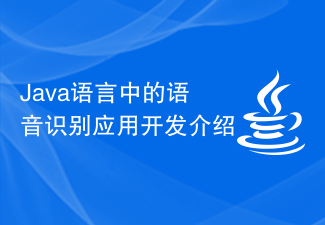 Java语言中的语音识别应用开发介绍Jun 10, 2023 am 10:16 AM
Java语言中的语音识别应用开发介绍Jun 10, 2023 am 10:16 AMJava语言作为目前最为流行的编程语言之一,其在各种应用开发领域中都有着广泛的应用。其中,语音识别应用是近年来备受瞩目的一个领域,尤其是在智能家居、智能客服、语音助手等领域中,语音识别应用已经变得不可或缺。本文将为读者介绍如何使用Java语言进行语音识别应用的开发。一、Java语音识别技术分类Java语音识别技术可以分为两种:一种是使用Java语言封装的第三
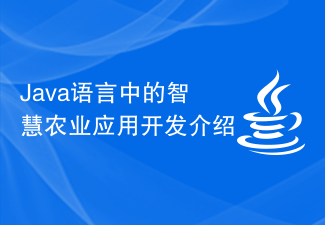 Java语言中的智慧农业应用开发介绍Jun 10, 2023 am 11:21 AM
Java语言中的智慧农业应用开发介绍Jun 10, 2023 am 11:21 AM随着时代的发展,农业领域也开始借助现代科技手段升级转型,智慧农业也因此应运而生。Java作为一种性能优异、可移植性强的计算机编程语言,具备着较高的普及度和应用价值,成为智慧农业应用开发的重要解决方案之一。本文旨在介绍Java语言中智慧农业应用的开发流程、应用场景和优势点等方面的内容。一、Java语言中智慧农业应用的开发流程智慧农业应用的开发流程分为需求分析、
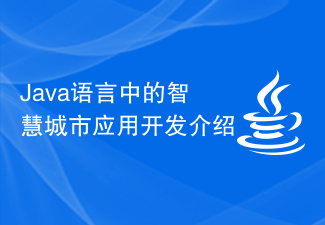 Java语言中的智慧城市应用开发介绍Jun 10, 2023 am 11:16 AM
Java语言中的智慧城市应用开发介绍Jun 10, 2023 am 11:16 AM智慧城市在不断发展,成为了城市建设的一个新的方向和目标。智慧城市通过人工智能、物联网技术等手段,实现城市的信息化、智能化和可持续化发展。而Java语言正是智慧城市应用开发的主要工具之一。一、Java语言在智慧城市应用开发中的作用Java语言作为一种主流编程语言,具有优秀的跨平台性和可移植性,能够适用于各种不同的操作系统和硬件平台。Java语言支持面向对象编程
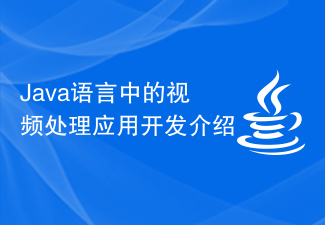 Java语言中的视频处理应用开发介绍Jun 10, 2023 pm 04:31 PM
Java语言中的视频处理应用开发介绍Jun 10, 2023 pm 04:31 PMJava语言中的视频处理应用开发介绍随着互联网和数字化技术的不断发展,视频已经成为人们生活中不可或缺的一部分。无论是短视频应用还是在线教育平台,视频都占据了重要的位置。其中,视频处理应用成为了热门关注的话题之一。本文将介绍Java语言中的视频处理应用开发。一、Java语言中的视频处理类库Java语言作为一门跨平台的程序语言,它的强大之处在于丰富的类库,其中也
 使用PHP和Google Cloud Functions实现轻量级应用开发和部署Jun 25, 2023 am 08:33 AM
使用PHP和Google Cloud Functions实现轻量级应用开发和部署Jun 25, 2023 am 08:33 AM在当前云计算和Web应用的时代,越来越多的业务需要轻量级的应用来完成,因此使用GoogleCloudFunctions和PHP来实现轻量级应用开发和部署是非常适合的。GoogleCloudFunctions是一种基于事件触发和无服务器计算的方法,用户只需要编写代码来处理这些事件,而不需要管理服务或维护服务器。此外,PHP是一种流行的编程语言,被广泛用
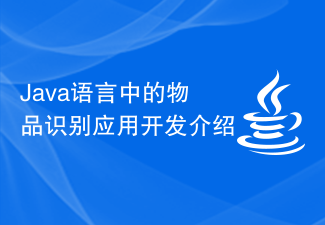 Java语言中的物品识别应用开发介绍Jun 09, 2023 pm 10:19 PM
Java语言中的物品识别应用开发介绍Jun 09, 2023 pm 10:19 PMJava语言中的物品识别应用开发介绍物品识别是一种使计算机能够识别和分类物品的技术,这种技术已经广泛应用于许多领域,如医学、安全、制造业、军事和机器人。这篇文章将介绍在Java语言中开发物品识别应用的相关技术和步骤。Java是一种广泛使用的编程语言,因其跨平台、安全性和可移植性而备受欢迎。在Java中开发物品识别应用需要使用以下技术:1.计算机视觉技术计算机
 Java语言中的电视应用开发介绍Jun 10, 2023 pm 07:49 PM
Java语言中的电视应用开发介绍Jun 10, 2023 pm 07:49 PM随着电视应用在生活中的普及,电视应用开发正变得越来越重要。在这个领域中,Java是一种经典的编程语言,被广泛应用于各种电视应用的开发。接下来,将会介绍Java语言在电视应用开发中的应用和相关知识。一、什么是电视应用开发?电视应用开发主要是指开发应用程序,以供电视机用户使用。这可以包括从基础的信息检索应用,到更复杂的互动游戏或购物应用。随着智能电视以及其他连接
 Java语言中的智能音箱应用开发介绍Jun 10, 2023 pm 06:56 PM
Java语言中的智能音箱应用开发介绍Jun 10, 2023 pm 06:56 PM随着人工智能的发展,智能音箱的应用越来越广泛。Java语言作为目前最流行的编程语言之一,也被广泛地应用于智能音箱的开发中。本文将简要介绍Java语言中的智能音箱应用开发。环境搭建Java语言开发智能音箱应用需要先搭建开发环境。开发环境的搭建主要包括:Java开发工具、开发板、音箱外壳、麦克风、扬声器等硬件设备的连接。针对智能音箱的特点,Java语言的开发常用


Hot AI Tools

Undresser.AI Undress
AI-powered app for creating realistic nude photos

AI Clothes Remover
Online AI tool for removing clothes from photos.

Undress AI Tool
Undress images for free

Clothoff.io
AI clothes remover

AI Hentai Generator
Generate AI Hentai for free.

Hot Article

Hot Tools

SublimeText3 English version
Recommended: Win version, supports code prompts!

SAP NetWeaver Server Adapter for Eclipse
Integrate Eclipse with SAP NetWeaver application server.

WebStorm Mac version
Useful JavaScript development tools

SublimeText3 Linux new version
SublimeText3 Linux latest version

MinGW - Minimalist GNU for Windows
This project is in the process of being migrated to osdn.net/projects/mingw, you can continue to follow us there. MinGW: A native Windows port of the GNU Compiler Collection (GCC), freely distributable import libraries and header files for building native Windows applications; includes extensions to the MSVC runtime to support C99 functionality. All MinGW software can run on 64-bit Windows platforms.






